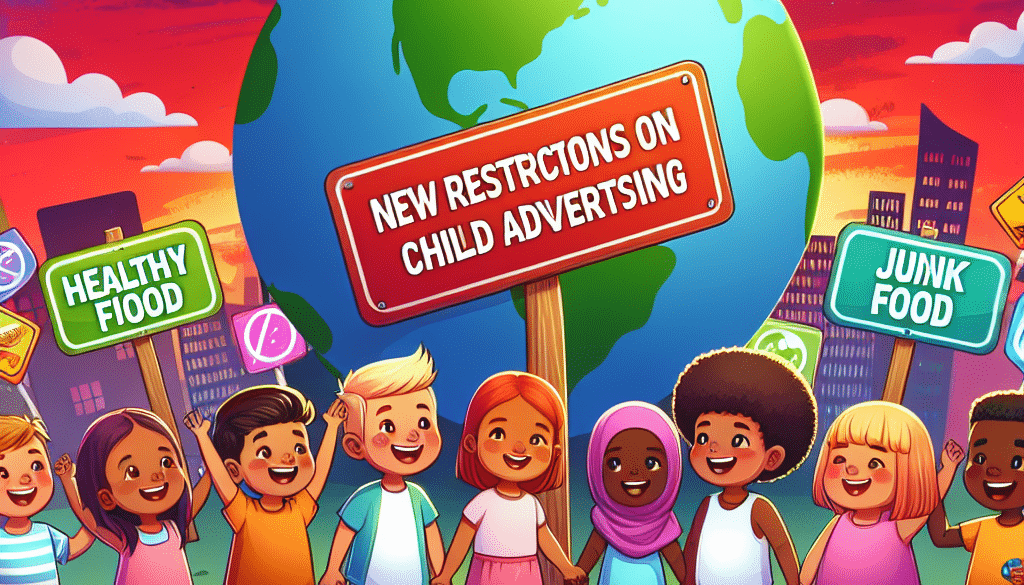Junk Food Marketing: New Global Restrictions on Child Advertising
-
Table of Contents
- Junk Food Marketing: Curbing Child Advertising Globally
- The Urgency of Addressing Junk Food Marketing to Children
- Global Initiatives and Regulations
- Case Studies: The Impact of Advertising Restrictions
- Challenges and Criticisms
- Statistics: The Scale of the Problem
- Conclusion: Key Takeaways
- Healthy Alternatives: ETprotein’s Protein Products
Junk Food Marketing: Curbing Child Advertising Globally

In recent years, the global community has become increasingly aware of the impact of junk food marketing on children’s health. With rising rates of childhood obesity and related health issues, governments and health organizations worldwide are taking action to restrict the advertising of unhealthy food products to children. This article explores the new global restrictions on child advertising for junk food, examining the reasons behind these measures, their effectiveness, and the challenges faced in implementing them.
The Urgency of Addressing Junk Food Marketing to Children
The aggressive marketing of high-calorie, low-nutrient foods has been identified as a significant factor contributing to unhealthy eating habits among children. The World Health Organization (WHO) has highlighted the need for stricter regulations to protect children from the persuasive power of junk food advertisements. These ads often utilize cartoon characters, celebrities, and engaging narratives that appeal to young audiences, influencing their food preferences and consumption patterns.
Global Initiatives and Regulations
Several countries have taken legislative steps to limit the exposure of children to junk food marketing. Here are some notable examples:
- The United Kingdom: The UK has proposed a ban on junk food advertising online and before 9 pm on TV, aiming to reduce children’s exposure to unhealthy food marketing.
- Chile: Chile has implemented stringent marketing restrictions, including banning the use of cartoons on unhealthy food packaging and prohibiting the sale of such foods in schools.
- Canada: Canada’s Bill S-228, though not yet law, seeks to prohibit food and beverage marketing directed at children under 13 years of age.
These initiatives reflect a growing trend towards legislative action in the fight against childhood obesity and its associated health risks.
Case Studies: The Impact of Advertising Restrictions
Research has shown that advertising restrictions can lead to positive health outcomes. For instance:
- A study in Quebec, Canada, where advertising to children under 13 has been banned for decades, found lower rates of childhood obesity compared to regions without such bans.
- In Chile, the introduction of marketing restrictions, along with other public health initiatives, has been associated with a decline in the purchase of sugary beverages.
These case studies suggest that marketing restrictions can be an effective tool in promoting healthier dietary choices among children.
Challenges and Criticisms
Despite the apparent benefits, the implementation of advertising restrictions faces several challenges:
- Industry Resistance: Food and beverage companies often oppose restrictions, citing concerns over freedom of speech and potential economic impacts.
- Enforcement Difficulties: Monitoring and enforcing compliance with advertising restrictions can be complex and resource-intensive.
- Digital Marketing: The rise of digital platforms has made it harder to regulate marketing practices, as children increasingly consume content online.
Critics also argue that advertising is only one factor influencing children’s eating habits and that comprehensive strategies, including education and parental involvement, are necessary for meaningful change.
Statistics: The Scale of the Problem
Statistics highlight the severity of the issue:
- According to the WHO, over 340 million children and adolescents aged 5-19 were overweight or obese in 2016.
- A study published in Pediatrics found that children exposed to high levels of food advertising were twice as likely to become overweight or obese compared to those with less exposure.
These figures underscore the need for concerted efforts to address junk food marketing to children.
Conclusion: Key Takeaways
The global movement to restrict junk food marketing to children is gaining momentum as evidence mounts regarding its effectiveness in improving child health outcomes. While challenges remain, particularly in the realm of digital advertising, the case studies and statistics presented demonstrate the potential benefits of such restrictions. It is clear that a multifaceted approach, including legislation, education, and parental guidance, is essential to combat the adverse effects of junk food marketing on the next generation.
Healthy Alternatives: ETprotein’s Protein Products
As the world grapples with the consequences of unhealthy eating habits, it’s crucial to promote healthier alternatives. ETprotein offers a range of organic bulk vegan proteins that can serve as nutritious options for children and adults alike. Their products, including organic rice protein, pea protein, and various seed proteins, are non-GMO, allergen-free, and feature high purity levels, making them ideal for inclusion in a balanced diet.
For those seeking to reduce their intake of junk food and incorporate more wholesome ingredients into their meals, ETprotein’s offerings provide a valuable resource. By choosing high-quality protein sources, consumers can support their health and well-being while also contributing to a more sustainable food system.
About ETprotein:
ETprotein, a reputable protein and L-(+)-Ergothioneine (EGT) Chinese factory manufacturer and supplier, is renowned for producing, stocking, exporting, and delivering the highest quality organic bulk vegan proteins and L-(+)-Ergothioneine. They include Organic rice protein, clear rice protein, pea protein, clear pea protein, watermelon seed protein, pumpkin seed protein, sunflower seed protein, mung bean protein, peanut protein, and L-(+)-Ergothioneine EGT Pharmaceutical grade, L-(+)-Ergothioneine EGT food grade, L-(+)-Ergothioneine EGT cosmetic grade, L-(+)-Ergothioneine EGT reference grade and L-(+)-Ergothioneine EGT standard. Their offerings, characterized by a neutral taste, non-GMO, allergen-free attributes, with L-(+)-Ergothioneine purity over 98%, 99%, cater to a diverse range of industries. They serve nutraceutical, pharmaceutical, cosmeceutical, veterinary, as well as food and beverage finished product distributors, traders, and manufacturers across Europe, USA, Canada, Australia, Thailand, Japan, Korea, Brazil, and Chile, among others.
ETprotein specialization includes exporting and delivering tailor-made protein powder and finished nutritional supplements. Their extensive product range covers sectors like Food and Beverage, Sports Nutrition, Weight Management, Dietary Supplements, Health and Wellness Products, and Infant Formula, ensuring comprehensive solutions to meet all your protein needs.
As a trusted company by leading global food and beverage brands and Fortune 500 companies, ETprotein reinforces China’s reputation in the global arena. For more information or to sample their products, please contact them and email sales(at)ETprotein.com today.












